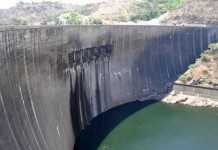A massive blasting operation designed to protect the 55 year old Kariba Dam on the Zambia/Zimbabwe border against foundation scour is likely to start in the next two months, NCE can reveal.
European Union (EU) funding has filled a funding gap that will allow the vital work to begin.
Almost 300,000m3 of hard granitic gneiss has to be carved out of the plunge pool below the dam to reduce the turbulence that threatens the dam wall’s foundations.
The pool has been eroded from a depth of 10m to a depth of 80m by the 9,000m3/s discharge from the six floodgates in the 128m high dam wall, but engineers believe that forming a series of rock steps in the downstream face of the pool will bring erosion under control. (see diagram)
The dam is owned jointly by Zambia and Zimbabwe, who have struggled to raise repair funding for several years.
A promised £60M EU contribution to a £150M three year rehabilitation programme should allow the work to begin during this year’s dry season, between July and October.
The 1M.m3 of mass concrete in the dam wall is also suffering from advanced alkali-silica reaction (ASR), which is threatening the operation of the floodgates and other hydromechanical facilities (see box).
Alkalai silica reaction unknown when the dam was first built
Aggregates for large dams were unlikely to be tested for alkali-silica reactivity in the 1950s, and more than 100 dams worldwide suffer the same phenomenon.
Kariba’s coarse aggregate was crushed local gneiss, with a maximum nominal size of 200mm. Washed Zambezi river sand was used as the fine aggregate, and the Ordinary Portland Cement (OPC) used came from the Chilanga Cement Works south of Lusaka. Again, its alkali levels would not have been seen as significant.
Cement contents were relatively low, as was normal for large mass concrete dams. Most of the more than 1M.m3 of concrete in the dam wall had an OPC content of 195kg/m3 and a water/cement (w/c) ratio of 0.6. A 3m thick layer on the upstream face had its cement content increased to 255kg/m3, with w/c ratio reduced to 0.5 for enhanced durability.
Even with these low cement contents, the risks of cracking due to the build up of heat resulting from cement hydration in the size of pours planned for Kariba required special attention by Italian main contractor Impresit.
Concrete was poured in blocks limited to 15m wide, 2.3m deep and up to 20m long. Cooling pipes were cast into the blocks and chilled water from a chiller plant on site circulated until the concrete had hardened and cooled. Finally the joints between the individual blocks were pressure grouted.
ASR was first detected in 1989 during a routine inspection. Quartz embedded in the gneiss coarse aggregate was blamed, and extensive monitoring equipment was gradually installed over subsequent years.
Floodgates began to scrape in 1992. A recent survey indicates that the dam was 80mm taller than when it first opened, a degree of expansion that seriously threatens the operation of the vital floodgate mechanisms.
Work to upgrade these is also included in the rehabilitation programme.
In a statement, the Zambezi River Authority (ZRA) deplored a recent media frenzy that alleged the dam could collapse within three years. It blamed misunderstanding of discussions at a fundraising conference in Zambia in March.
“ZRA regrets the misinterpretation on the facts about the Kariba Dam wall impending collapse, which caused alarm among stakeholders and the public in general,” said ZRA communications manager Elizabeth Karonga.
“While the situation at the Kariba Dam wall is cause for grave concern, the engineers on the ground have the situation under control. This does not translate to an immediate calamity. However, all urgency is expected in order to avert any such catastrophe as dam failure.”
Local politicians have also been accused of fuelling the media hype by issuing contradictory and alarmist statements. They need to convince outside funding agencies of the urgent need for major rehabilitation of the dam without causing unnecessary panic among those who would be directly affected by a major failure.
The World Bank and the African Development Bank are also reported as having pledged funding, but this has yet to be officially confirmed.
A Kariba collapse would release 185km3 of water, threaten the lives of 3.5M people and flood the Zambian capital Lusaka.
Around 1.3GW of electricity generating capacity would be lost across the region. It would be a repeat on a massive scale of the 1959 collapse of the Malpasset dam in the South of France, which was also the work of Kariba Dam designer André Coyne (see box).
Fears of collapse have been exacerbated by recent reports that climate change would lead to more extreme flooding in the Zambezi catchment area. Nightmare scenarios include all six floodgates having to be opened at the same time for the first time in more than three decades, thus accelerating scour and triggering a foundation failure. Alternatively, the gates could jam due to ASR expansion, leading to overtopping and wall collapse.

But MWH technical director for international dams and hydropower Peter Mason said that the impact of climate change was likely to be minimal.
Mason has researched the possible impact of climate variations and ASR on several dams including Kariba.
“The Zambezi basin goes through natural rainfall cycles,” he said. “There was massive flooding during the dam’s construction, and the number of floodgates was increased from four to six.
“For the first 20 years of operations the gates were opened regularly and almost all the erosion took place then. They haven’t been used much recently, due to lower rainfall and the commissioning of the North Bank power station.”
Currently the dam operators are limited to opening a maximum of three gates at once to minimise scour. Fissures in the riverbed gneiss allow the dam’s discharge to break away large masses of rock.
Kariba: A tragic lesson from the past
Built on gneiss like the Kariba Dam, the 60m high concrete arch Malpasset Dam in the South of France was also designed by French engineer André Coyne.
It was completed in 1954, but on 2 December 1959 it collapsed, releasing a 40m high wall of water that killed 423 people.
The villages of Malpasset and Bozon were completely destroyed. Twenty minutes after the collapse, the wave – still 10m high – hit the seaside city of Fréjus, 7km to the south, causing widespread devastation.
There had been heavy rain in the days preceding the collapse, and water levels behind the dam were unusually high.
Delays in opening the flood-gates were partially blamed by subsequent inquiries, but the main cause of the disaster was held to be a tectonic fault in the underlying gneiss.
Coyne never recovered from the shock of the disaster, and he died soon afterwards at the age of 69.
These boulders then circulate in the plunge pool, causing more fragmentation.
Blasting operations will almost certainly take place in the dry behind a temporary cofferdam.
Concerns about the long term functioning of the floodgates centre mainly on the affects of ASR, although there have been problems with concrete carbonation leading to reinforcement spalling in those areas adjacent to the gates.
The upstream stop beam guides that allow for temporary dewatering of the sluices so that work can take place on the gates need to be refurbished and strengthened.

And the ZRA plans to install an emergency gate that would come into operation in the event of a floodgate failure.
Mason said a team of French engineers regularly inspects the dam, and the problems have been known about for some time.
He added: “The structure is still essentially sound, particularly as Kariba is an arch dam.
“Not a lot can be done about the ASR, we just have to understand what future expansion to expect
“Gates can be made adjustable to compensate for concrete distortion. And the scour problem is controllable and doesn’t threaten the dam’s stability. However, any artificial enlargement of the scour hole should be done with care.”

 JOIN DRIVERN TAXI AS PARTNER DRIVER TODAY!
JOIN DRIVERN TAXI AS PARTNER DRIVER TODAY!











